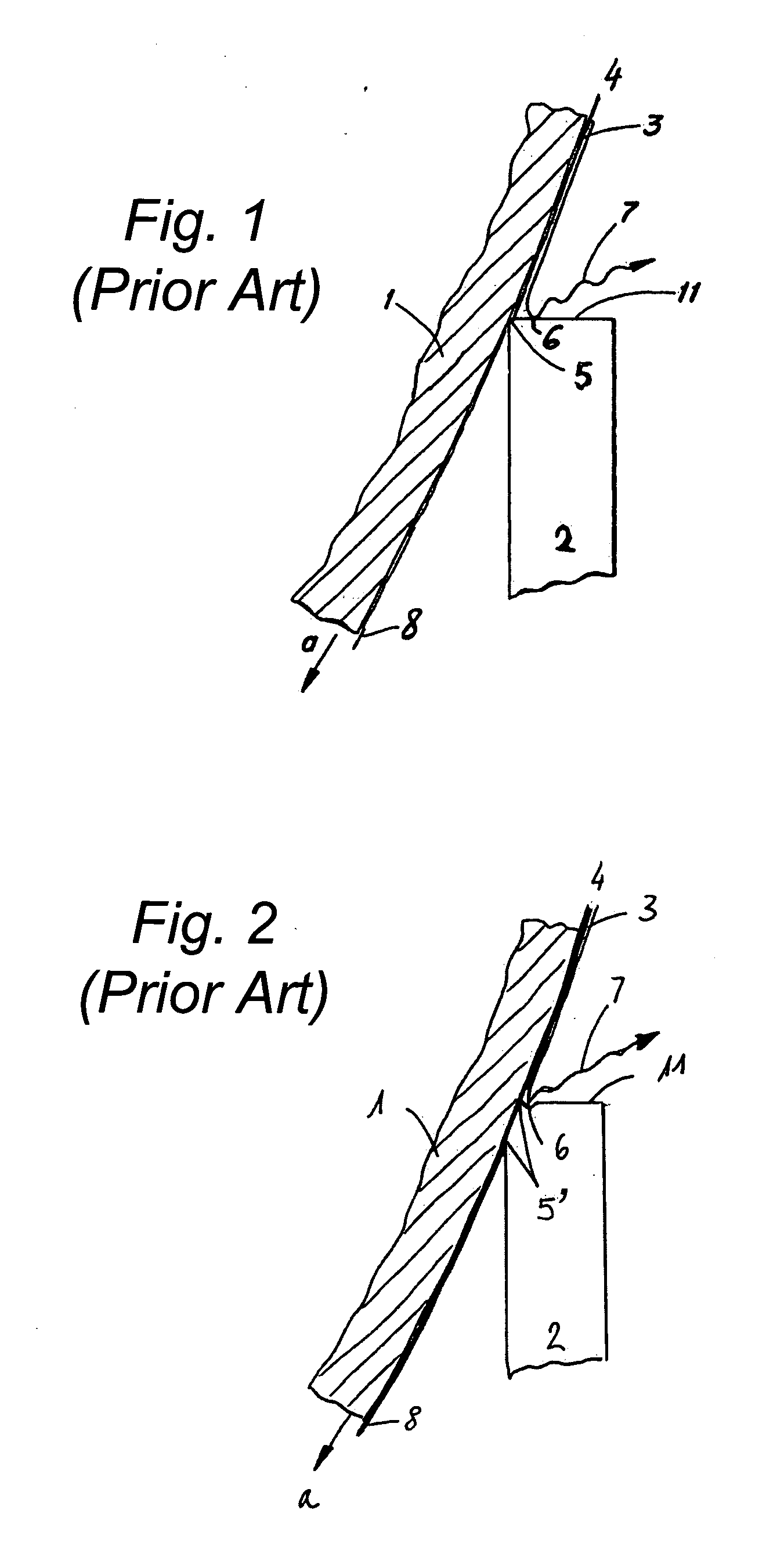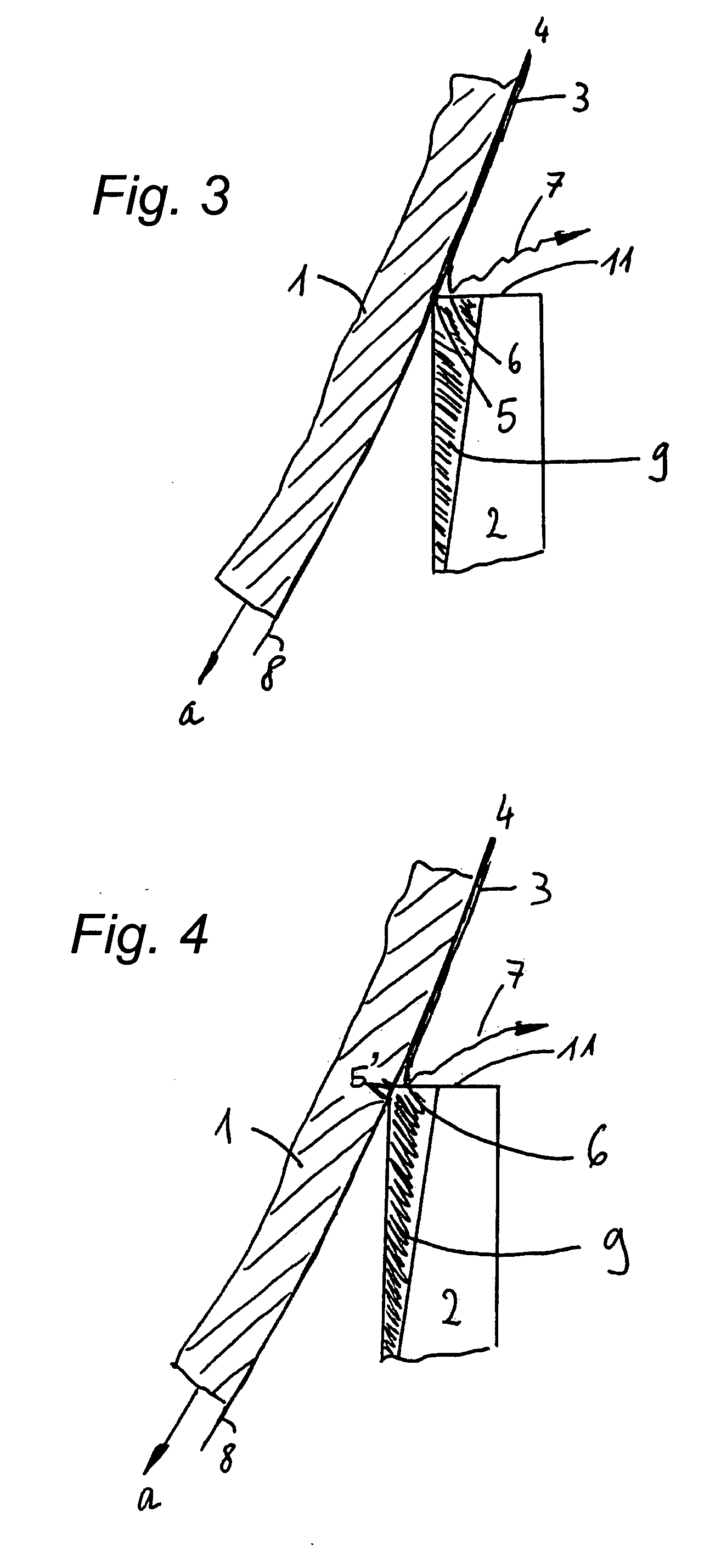Creping blade
a creping blade and blade technology, applied in the field of creping blades, can solve the problems of affecting the smoothness of the blade, the blade should be predominantly or exclusively worn, and the creping blade is subject to wear, so as to improve the toughness, facilitate the coiling of the blade, and reduce the hardness of the ceramic deposi
- Summary
- Abstract
- Description
- Claims
- Application Information
AI Technical Summary
Benefits of technology
Problems solved by technology
Method used
Image
Examples
example 1
[0058] In a tissue mill, trials were performed with three different types of creping blades. The first type, labeled A, was a blade according to the present invention, having a ceramic top coating of chromia-titania with 15% titania content. The second type, labeled B, was a prior art ceramic tipped blade with an alumina-based material for the ceramic coating. The third type, labeled C, was a prior art metal carbide blade.
[0059] The running conditions for the creping process were the following: [0060] paper web made from 100% recycled fibers; [0061] industrial towel type tissue; [0062] grammages of 19, 22 and 28 g / m2, with wet strength; [0063] Yankee speed of 1050 m / min; [0064] Crepe ratio of 15%; [0065] Yankee surface comprised of Metso Curemate-78, a HVOF WC-Co-Cr coating; [0066] web moisture of 3.5-4%; [0067] creping blade dimensions of 1.2×100×2980 mm (thickness×width×length); [0068] a blade bevel of 85 degrees (−5 degrees from square edge); [0069] a blade load of 2.5 bars (280...
example 2
[0079][0079] On another tissue machine, currently employing alumina-based creping blades, a trial of ten blades according to the invention was performed.
[0080] The running conditions for the creping process were the following: [0081] paper web made from 100% deinked fibers (recycled); [0082] toilet paper tissue type; [0083] grammage of 16 g / m2; [0084] Yankee speed of 770 m / min; [0085] Yankee surface comprised of cast iron; [0086] Reel speed of 560 m / min (crepe ratio 27%); [0087] web moisture of 3%; [0088] creping blade dimensions of 1.2×120×3420 mm (thickness×width×length); [0089] a blade bevel of 85 degrees (−5 degrees from square edge); [0090] a blade load of 2.5 kN / m; [0091] a stick-out of 60 mm.
[0092] The ceramic blades currently used on this machine exhibits a very large variation in blade lifetime, ranging from 1 hour up to over 100 hours. The lifetime of the currently used alumina-based ceramic tipped blades is limited mainly by chipping problems, and the average lifetime i...
example 3
[0098] On yet another tissue machine, currently employing alumina-based ceramic tipped creping blades, a comparative trial was performed between state of the art blades and blades according to the present invention.
[0099] The running conditions for the creping process were the following: [0100] paper web made from 100% virgin fibers; [0101] soft toilet paper tissue type [0102] grammage of 21 g / m2; [0103] Yankee speed of 1100 m / min; [0104] Yankee surface comprised of cast iron; [0105] creping blade dimensions of 1.2×120×2790 mm (thickness×width×length); [0106] blade bevel of 75 degrees (−15 degrees from square edge).
[0107] State of the art ceramic tipped and metal carbide tipped blades were compared to a blade according to the present invention. The blade according to the invention had a 90% chromia—10% titania composition. In this case, the softness attributed value is an important criteria for this tissue mill. The three blade types were run for about 8 hours during 3 consecutive...
PUM
| Property | Measurement | Unit |
|---|---|---|
| Fraction | aaaaa | aaaaa |
| Percent by mass | aaaaa | aaaaa |
| Thickness | aaaaa | aaaaa |
Abstract
Description
Claims
Application Information
 Login to View More
Login to View More - R&D
- Intellectual Property
- Life Sciences
- Materials
- Tech Scout
- Unparalleled Data Quality
- Higher Quality Content
- 60% Fewer Hallucinations
Browse by: Latest US Patents, China's latest patents, Technical Efficacy Thesaurus, Application Domain, Technology Topic, Popular Technical Reports.
© 2025 PatSnap. All rights reserved.Legal|Privacy policy|Modern Slavery Act Transparency Statement|Sitemap|About US| Contact US: help@patsnap.com



